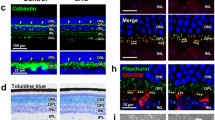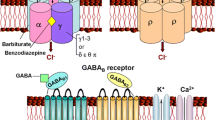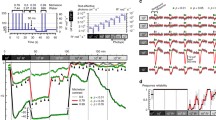Abstract
This study investigated visual response properties of retinal ganglion cells (RGCs) under high glucose levels. Extracellular single-unit responses of RGCs from mouse retinas were recorded. And the eyecup was prepared as a flat mount in a recording chamber and superfused with Ames medium. The averaged RF size of the ON RGCs (34.1±2.9, n=14) was significantly smaller than the OFF RGCs under the HG (49.3±0.3, n=12) (P<0.0001) conditions. The same reduction pattern was also observed in the osmotic control group (HM) between ON and OFF RGCs (P<0.0001). The averaged luminance threshold (LT) of ON RGCs increased significantly under HG or HM (HG: P<0.0001; HM: P<0.0002). OFF RGCs exhibited a similar response pattern under the same conditions (HG: P<0.01; HM: P<0.0002). The averaged contrast gain of ON cells was significantly lower than that of OFF cells with the HM treatment (P<0.015, unpaired Student’s t test). The averaged contrast gain of ON cells was significantly higher than OFF cells with the HG treatment (P<0.0001). The present results suggest that HG reduced receptive field center size, suppressed luminance threshold, and attenuated contrast gain of RGCs. The impact of HG on ON and OFF RGCs may be mediated via different mechanisms.
Similar content being viewed by others
References
Bloodworth, J.M. (1962). Diabetic retinopathy. Diabetes 11, 1–22.
Camera, A., Hopps, E., and Caimi, G. (2007). Diabetic microangiopathy: physiopathological, clinical and therapeutic aspects. Minerva Endocrinol 32, 209–229.
Ewing, F.M.E., Deary, I.J., Strachan, M.W.J., and Frier, B.M. (1998). Seeing beyond retinopathy in diabetes: electrophysiological and psychophysical abnormalities and alterations in vision. Endocr Rev 19, 462–476.
Kowluru, R.A., and Mishra, M. (2015). Contribution of epigenetics in diabetic retinopathy. Sci China Life Sci 58, 556–563.
Barber, A.J. (2015). Diabetic retinopathy: recent advances towards understanding neurodegeneration and vision loss. Sci China Life Sci 58, 541–549.
Kern, T.S., and Barber, A.J. (2008). Retinal ganglion cells in diabetes. J Physiol 586, 4401–4408.
Shanab, A.Y., Nakazawa, T., Ryu, M., Tanaka, Y., Himori, N., Taguchi, K., Yasuda, M., Watanabe, R., Takano, J., Saido, T., Minegishi, N., Miyata, T., Abe, T., and Yamamoto, M. (2012). Metabolic stress response implicated in diabetic retinopathy: the role of calpain, and the therapeutic impact of calpain inhibitor. Neurobiol Dis 48, 556–567.
Liu, J., Yeung, P.K.K., Cheng, L., Lo, A.C.Y., Chung, S.S.M., and Chung, S.K. (2015). Epac2-deficiency leads to more severe retinal swelling, glial reactivity and oxidative stress in transient middle cerebral artery occlusion induced ischemic retinopathy. Sci China Life Sci 58, 521–530.
He, M., Pan, H., **ao, C., and Pu, M. (2013). Roles for redox signaling by NADPH oxidase in hyperglycemia-induced heme oxygenase-1 expression in the diabetic retina. Invest Ophthalmol Vis Sci 54, 4092–4101.
**ao, C., He, M., Nan, Y., Zhang, D., Chen, B., Guan, Y., and Pu, M. (2012). Physiological effects of superoxide dismutase on altered visual function of retinal ganglion cells in db/db mice. PLoS ONE 7, e30343.
Sagdullaev, B.T., and McCall, M.A. (2005). Stimulus size and intensity alter fundamental receptive-field properties of mouse retinal ganglion cells in vivo. Vis Neurosci 22, 649–659.
**a, H., Nan, Y., Huang, X., Gao, J., and Pu, M. (2015). Effects of tauroursodeoxycholic acid and alpha-lipoic-acid on the visual response properties of cat retinal ganglion cells: an in vitro study. Invest Ophthalmol Vis Sci 56, 6638–6645.
Sun, W., Li, N., and He, S. (2002). Large-scale morphological survey of mouse retinal ganglion cells. J Comp Neurol 451, 115–126.
Hu, J., Wu, Q., Li, T., Chen, Y., and Wang, S. (2013). Inhibition of high glucose- induced VEGF release in retinal ganglion cells by RNA interference targeting G protein-coupled receptor 91. Exp Eye Res 109, 31–39.
Hao, M., Kuang, H.Y., Fu, Z., Gao, X.Y., Liu, Y., and Deng, W. (2012). Exenatide prevents high-glucose-induced damage of retinal ganglion cells through a mitochondrial mechanism. Neurochem Int 61, 1–6.
Cao, Y., Li, X., Wang, C.J., Li, P., Yang, B., Wang, C.B., and Wang, L.X. (2015). Role of NF-E2-related factor 2 in neuroprotective effect of L-carnitine against high glucose-induced oxidative stress in the retinal ganglion cells. Biomed Pharmacother 69, 345–348.
Cao, Y., Wang, L., Zhao, J., Zhang, H., Tian, Y., Liang, H., and Ma, Q. (2016). Serum response factor protects retinal ganglion cells against high-glucose damage. J Mol Neurosci 59, 232–240.
Hao, M., Li, Y., Lin, W., Xu, Q., Shao, N., Zhang, Y., and Kuang, H. (2015). Estrogen prevents high-glucose-induced damage of retinal ganglion cells via mitochondrial pathway. Graefes Arch Clin Exp Ophthalmol 253, 83–90.
Fu, D., Wu, M., Zhang, J., Du, M., Yang, S., Hammad, S.M., Wilson, K., Chen, J., and Lyons, T.J. (2012). Mechanisms of modified LDL-induced pericyte loss and retinal injury in diabetic retinopathy. Diabetologia 55, 3128–3140.
Nagai, N., Tanino, T., and Ito, Y. (2015). Excessive interleukin 18 relate the aggravation of indomethacin-induced intestinal ulcerogenic lesions in adjuvant-induced arthritis rat. Biol Pharmaceut Bull 38, 1580–1590.
Scuderi, S., D’amico, A.G., Federico, C., Saccone, S., Magro, G., Bucolo, C., Drago, F., and D’Agata, V. (2015). Different retinal expreßsion patterns of IL-1a, IL-1β, and their receptors in a rat model of type 1 STZ-induced diabetes. J Mol Neurosci 56, 431–439.
Dibas, A., Yang, M.H., Bobich, J., and Yorio, T. (2007). Stress-induced changes in neuronal Aquaporin-9 (AQP9) in a retinal ganglion cell-line. Pharmacol Res 55, 378–384.
Jang, S.Y., Lee, E.S., Ohn, Y.H., and Park, T.K. (2016). Expression of aquaporin- 6 in rat retinal ganglion cells. Cell Mol Neurobiol 36, 965–970.
Miki, A., Kanamori, A., Negi, A., Naka, M., and Nakamura, M. (2013). Loss of aquaporin 9 expression adversely affects the survival of retinal ganglion cells. Am J Pathol 182, 1727–1739.
Hou, R., Zhang, Z., Yang, D., Wang, H., Chen, W., Li, Z., Sang, J., Liu, S., Cao, Y., **e, X., Ren, R., Zhang, Y., Sabel, B.A., and Wang, N. (2016). Pressure balance and imbalance in the optic nerve chamber: the Bei**g Intracranial and Intraocular Pressure (iCOP) Study. Sci China Life Sci 59, 495–503.
Li, M., Wang, H., Liu, Y., Zhang, X., and Wang, N. (2016). Comparison of time-domain, spectral-domain and swept-source OCT in evaluating aqueous cells in vitro. Sci China Life Sci 59, 1319–1323.
Sang, J., Jia, L., Zhao, B., Wang, H., Zhang, N., and Wang, N. (2016). Association of three single nucleotide polymorphisms at the SIX1-SIX6 locus with primary open angle glaucoma in the Chinese population. Sci China Life Sci 59, 694–699.
Nan, Y., **ao, C., Chen, B., Ellis-Behnke, R.G., So, K.F., and Pu, M. (2010). Visual response properties of Y cells in the detached feline retina. Invest Ophthalmol Vis Sci 51, 1208–1215.
Pu, M., Xu, L., and Zhang, H. (2006). Visual response properties of retinal ganglion cells in the royal college of surgeons dystrophic rat. Invest Ophthalmol Vis Sci 47, 3579–3585.
Acknowledgements
This work was supported by the National Basic Research Program of China (2015CB351806 to Mingliang Pu), the National Science Foundation of China (31571091 to Mingliang Pu) and the Science and Technology Planning Project of China Hunan Provincial Science and Technology Department (2015SK2046 to Chunxia **ao).
Author information
Authors and Affiliations
Corresponding authors
Rights and permissions
About this article
Cite this article
Zhou, Y., **ao, C. & Pu, M. High glucose levels impact visual response properties of retinal ganglion cells in C57 mice—An in vitro physiological study. Sci. China Life Sci. 60, 1428–1435 (2017). https://doi.org/10.1007/s11427-017-9106-6
Received:
Revised:
Published:
Issue Date:
DOI: https://doi.org/10.1007/s11427-017-9106-6




